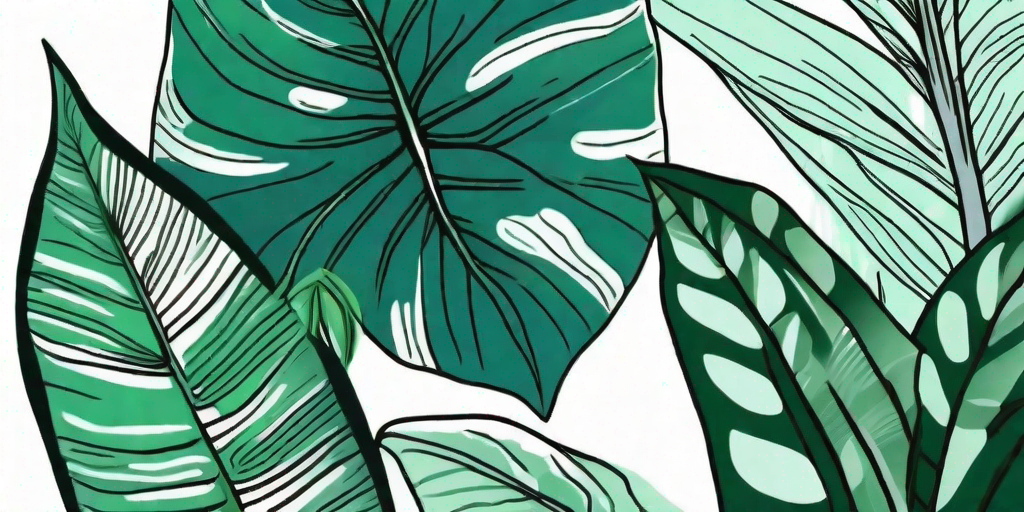
Dieffenbachia, also known as the "dumb cane" (don't worry, it's not an insult to its intelligence), is a tropical plant that has been gracing our homes with its lush, patterned foliage for years. Originating from the tropical regions of the Americas, these plants are a popular choice for indoor gardening due to their easy maintenance and striking appearance. But with so many varieties to choose from, how do you pick your perfect Dieffenbachia? Fear not, plant lovers, we're here to guide you through the jungle of Dieffenbachia varieties.
The Dieffenbachia's Diverse Portfolio
Dieffenbachia boasts over 30 species, each with its own unique charm. Some are compact and perfect for your desk, while others can grow as tall as your ceiling. Some have leaves that look like they've been painted by an artist, while others keep it simple with a classic green. Let's dive into some of the most stunning varieties that you can bring into your home.
But before we do, remember: beauty is in the eye of the beholder. What might be the 'Beyonce of Dieffenbachias' to one person might just be 'meh' to another. So, keep an open mind and let your plant-loving heart guide you.
Dieffenbachia Camille
The Dieffenbachia Camille is like the girl next door of the Dieffenbachia world. It's friendly, approachable, and has a classic beauty that never goes out of style. Its leaves are a vibrant green with a creamy white center, making it a perfect addition to any room that needs a touch of nature's charm.
It's also one of the smaller varieties, growing up to 3 feet tall. So, if you're looking for a Dieffenbachia that won't take over your living room, Camille might just be your girl.
Dieffenbachia Tropic Snow
Next up is the Dieffenbachia Tropic Snow. Now, this one is a bit of a show-off. Its large, oval leaves are a deep green with a dramatic white center. It's like Mother Nature took a paintbrush and created a masterpiece. And the best part? It can grow up to 6 feet tall, making it a perfect statement piece for your home.
But don't let its size intimidate you. The Tropic Snow is just as easy to care for as its smaller counterparts. Just give it plenty of indirect light and keep its soil moist, and it'll reward you with its stunning foliage.
Caring for Your Dieffenbachia
Now that you've met some of the Dieffenbachia's most stunning varieties, let's talk about how to keep them happy and healthy. After all, a happy plant is a beautiful plant.
Dieffenbachias are pretty low-maintenance, but there are a few things you should keep in mind. They love indirect light, so place them near a window where they can bask in the sun's rays without getting sunburned. Yes, plants can get sunburned too!
Watering Your Dieffenbachia
When it comes to watering your Dieffenbachia, it's all about balance. Too much water and you'll drown it, too little and it'll dry out. Aim to keep the soil moist, but not waterlogged. A good rule of thumb is to water it when the top inch of soil feels dry to the touch.
And remember, Dieffenbachias are tropical plants, so they love humidity. If your home is on the dry side, consider placing your plant on a tray of pebbles filled with water to increase the humidity around it.
Feeding Your Dieffenbachia
Like all living things, Dieffenbachias need food to grow. Feed your plant with a balanced houseplant fertilizer every month during the growing season (spring and summer). But be careful not to overfeed it, as this can cause the leaves to burn.
During the winter months, you can cut back on feeding as the plant goes into a dormant state. Think of it as its winter hibernation.
FAQs
- Are Dieffenbachias toxic?
Yes, Dieffenbachias are toxic if ingested, so they're not the best choice if you have curious pets or children. The plant contains calcium oxalate crystals, which can cause irritation and swelling of the mouth and throat.
- Why are the leaves on my Dieffenbachia turning yellow?
Yellow leaves can be a sign of overwatering. Remember, Dieffenbachias like their soil to be moist, but not waterlogged. If the leaves continue to yellow even after adjusting your watering schedule, it might be a sign of a nutrient deficiency.
- Can I propagate my Dieffenbachia?
Absolutely! Dieffenbachias are relatively easy to propagate. Just cut a stem from the mother plant, making sure it has at least one leaf, and place it in water. Once roots have formed, you can plant it in soil.
Conclusion
There you have it, a comprehensive guide to the most stunning varieties of Dieffenbachia. Whether you're a seasoned plant parent or a newbie, these plants are a great addition to any indoor garden. They're easy to care for, come in a variety of shapes and sizes, and their lush, patterned foliage can brighten up any room.
So, what are you waiting for? It's time to unleash the beauty of Dieffenbachia in your home!















